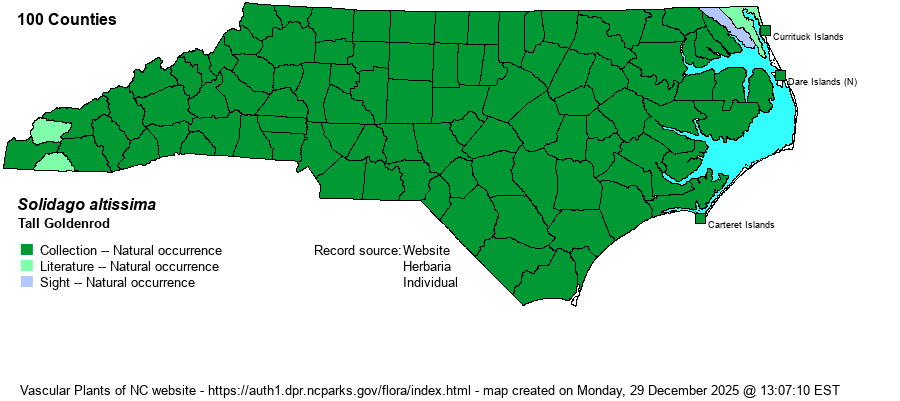| Author | L. | |
| Distribution | Throughout the state, including the Outer Banks. Taxon editors do not recognize var. pluricephala (which see); we simply treat the species in NC as having no varieties.
N.S. to Sask., south to northern GA, AR, and OK.
| |
| Abundance | Generally abundant across the state, perhaps slightly less so in the far northeastern corner of the state. One of the most numerous native dicot species in the state. | |
| Habitat | Dry to mesic to moist fields, meadows, woodland and forest clearings, clearcuts, powerlines, roadsides. Can be the dominant plant a few years after abandonment of a clearing/cropland. |
| Phenology | Flowering and fruiting August-October. | |
| Identification | Tall Goldenrod is among our tallest goldenrod species, and should be familiar to all people. It typically grows to 3-6 feet but can be as much as 7.5 feet. Stems are very leafy, the leaves lance-shape, tapered to a point, and toothed on margins. Stems are hairy; the leaves are very short-hairy beneath and rough above. The inflorescence is typically triangular in outline and tapers to a point; the branches are usually curved. It closely resembles Giant Goldenrod (S. gigantea), but that species has glabrous stems which are also glaucescent (can appear whitish or pinkish in color); that species is essentially restricted to wetlands, though Tall Goldenrod can grow with it in wetlands. | |
| Taxonomic Comments | In NC the website editors do not recognize any infraspecific taxa at this time (see text for var. pluricephala).
| |
| Other Common Name(s) | Canada Goldenrod, Late Goldenrod | |
| State Rank | S5 | |
| Global Rank | G5 | |
| State Status | | |
| US Status | | |
| USACE-agcp | FACU link |
| USACE-emp | FACU link |

